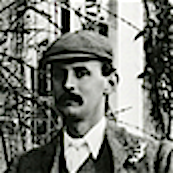
Sidney Howard Barnsley [commonly known as Sidney Barnsley] was born in Birmingham, England on 25 April 1865. His family owned a local building firm, John Barnsley & Sons. After studying at Birmingham Municipal School of Art, he was articled to Richard Norman Shaw (1831-1912) in London from 1885 to 1888. He also attended the Royal Academy Architectural School in London. After leaving Shaw, he spent two extended study tours of Greece with his friend and fellow architect Robert Weir Schultz (1860-1951), later known as Robert Schultz Weir. He also attended the British School at Athens.
Following his return to England in November 1890, he lodged for a period with Ernest Gimson in London and established an office with Schultz at 14 Gray's Inn Square, London in 1891. He also became a partner in Kenton & Co., a short-lived cabinet-making workshop established in London by Gimson, Mervyn Macartney, Reginald Blomfield, Stephen Webb, and his older brother, Ernest Barnsley (1863-1926). A table designed by Sidney Barnsey for Kenton & Co. is in the permanent collection of the William Morris Gallery in London.
In 1892 Barnsley designed his first significant architectural commission, the Church of the Wisdom of God at Lower Kingswood in Surrey, built by the local building firm Mees & Sons. The cloister with its floral mosaic apse and Byzantine-inspired gold mosaic dome, show the influence of the churches he visited in Greece.
Kenton & Co. closed in 1892 and the following year Barnsley along with Gimson moved to Ewen in the Cotswolds, and established a furniture workshop at Pinsbury Park, a few miles away. In 1902 they relocated their workshop to the nearby village of Sapperton, however, because of a disagreement between Gimson and Ernest Barnsley, the partnership between the three designers dissolved.
Sidney Barnsley remained in Sappertom where he built Beechanger, a house for himself and his family, and continued to design and make furniture from a workshop in his garden. He and Gimson emained close friends and met up more or less daily in their respective workshops.
From 1913 onwards Barnsley received more commissions for architectural work and he designed extensions and additions for a number of large houses in the Cotswolds.
Following the death of Gimson in August 1919, he saw to the completion of his outstanding work. This included the chancel screen at Crockham Hill Church in Surrey and furniture for G. F. B. de Gruchy in Jersey.
Sidney Barnsley participated in the 4th (1893), 5th (1896), 6th (1899), 7th (1903), 8th (1906), 9th (1910) and 11th (1916) exhibitions of the Arts & Crafts Exhibition Society in London.
Towards the end of his career, Sidney worked on the interior furnishing of Rodmarton Manor in Rodemarton, south of Cirencester designed by Ernest Barnsley and commissioned by Claud Biddulph, a banker, in 1909.
Sidney Barnsley died in Sapperton Gloucestershire on 25 September 1926. He had two children, (Emily) Grace Barnsley (1896–1975), who became a pottery decorator, and (William) Edward Barnsley (1900–1987) who was a designer-craftsman.
Cheltenham Art Gallery and Museum has more that 250 designs for furniture and architecture by Sidney Barnsley.
St. Sophia's church, Lower Kingswood, Surrey (1891); Beechanher, Sapperton, Gloucestershire (c.1901); and Gyde Almshouses, Painswick, Gloucestershire (c.1913);
See also: Historic England - contains over 30 records of work by Sidney Barnsley
Avery, Derek. Victorian and Edwardian Architecture. London: Chaucer Press, 2003
Brandon, Martin. The Lost Jewel in the Arts & Crafts Crown: the Church of the Wisdom of God, Lower Kingswood'. B.A. dissertation, Southampton Institute, 2001
Button, Roger. Arts and Crafts Churches of Great Britain: Architects, Craftsmen and Patrons.. Settle, North Yorkshire: 2QT Ltd. (Publishing) Ltd., 2020
Carruthers, Annette and Greensted, Mary. Good citizen’s furniture: the Arts and Crafts collections at Cheltenham. Cheltenham and Aldershot: Cheltenham Art Gallery and Museums in association with Lund Humphries, 1994
Directory of British Architects 1834-1914. Compiled by Antonia Brodie, et al. Volume 1: A-K. London; New York: British Architectural Library, Royal Institute of British Architects/Continuum, 2001
Good citizen's furniture": the work of Ernest and Sidney Barnsley. Cheltenham: Cheltenham Art Gallery and Museum, 1976
Gray, A. Stuart. Edwardian architecture: a biographical dictionary. London: Gerald Duckworth & Co., Ltd., 1985
Greensted, Mary. The Arts and Crafts Movement: Exchanges Between Greece and Britain (1876-1930). M.Phil. thesis, University of Birmingham, 2010
Hamilton, Alec. Arts & Crafts Churches. London: Lund Humphries, 2020
Kalligas, Haris. ' Twin reflections of a Byzantine city : Monemvasia as seen by Robert Weir Schultz and Sidney H. Barnsley in 1890' Society for the Promotion of Byzantium Studies no. 7, 2000 pp. 23-44
Lambourne, Lionel. Utopian Craftsmen. The Arts and Crafts Movement from the Cotswolds to Chicago. London: Astragal Books, 1980
McGrath, Mike. ‘Sidney Barnsley, a Quintessential Arts and Crafts Architect and Craftsman’ in Originality and initiative: the Arts and Crafts archives at Cheltenham. Edited by Mary Greensted and Sophia Wilson. Cheltenham and Aldershot: Cheltenham Art Gallery and Museums in association with Lund Humphries, 2003 pp. 45-60.
Originality and Initiative. The Arts and Crafts Archives in Cheltenham. Edited by Mary Greensted and Sophia Wilson. Cheltenham and Aldershot: Cheltenham Art Gallery and Museum in association with Lund Humphries, 2003